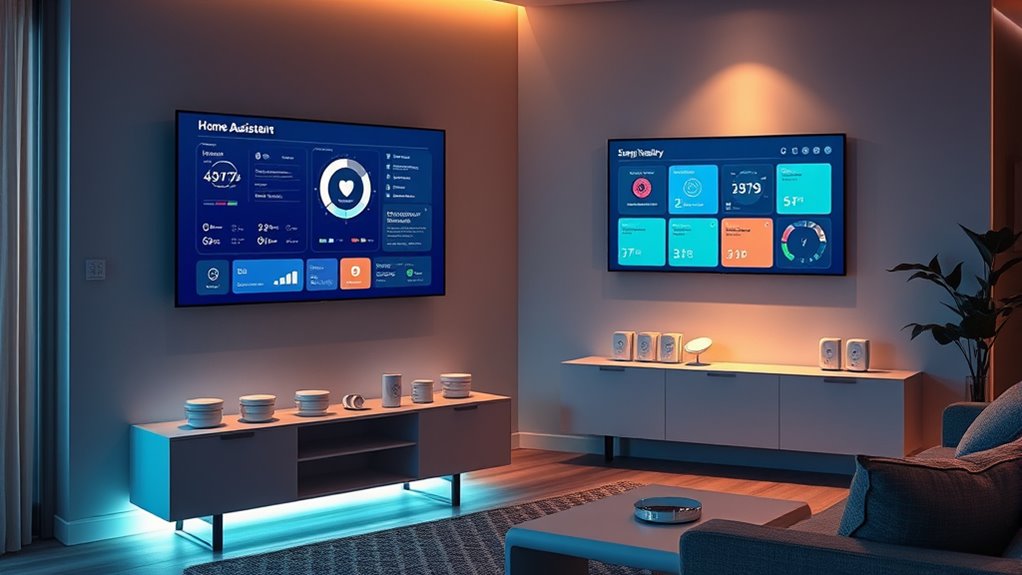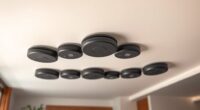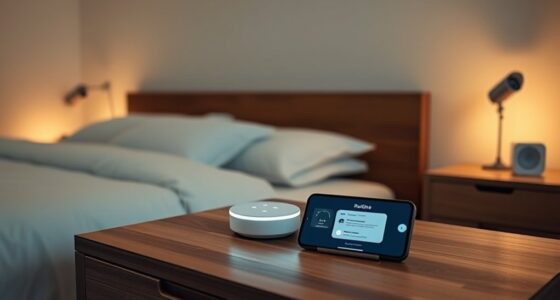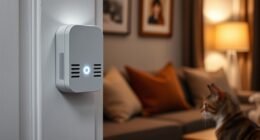To use Home Assistant as a security-focused automation hub, you can set up dedicated dashboards for quick access to security devices like cameras, sensors, and alarms. Enable motion detection, facial recognition, and real-time alerts to monitor your home effectively. Automate responses such as turning on lights or sounding alarms when threats are detected. To strengthen your setup, focus on privacy controls and encryption. Keep exploring how to optimize your system further for a safer, smarter home.
Key Takeaways
- Create a dedicated security dashboard to organize devices, automations, and alerts for quick access during emergencies.
- Integrate high-quality motion sensors and facial recognition cameras for accurate activity detection and identification.
- Automate security responses like lighting, alarms, and locking doors based on sensor triggers and facial recognition results.
- Set up real-time alerts via SMS, email, or push notifications for suspicious activity or security breaches.
- Regularly review access logs, enable encryption, and manage user permissions to maintain data privacy and system integrity.
Setting Up Your Home Assistant Security Environment
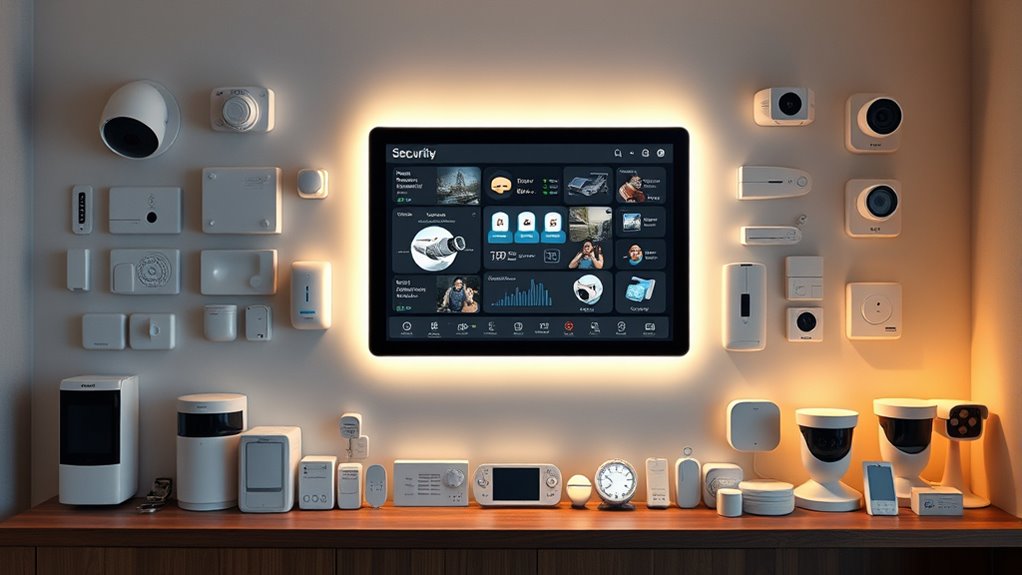
To effectively secure your smart home, you need to set up a dedicated security environment within Home Assistant. Start by creating a separate dashboard or folder for security devices and automations. Enable motion detection on your cameras and sensors to monitor activity around your property. Use facial recognition to identify familiar faces and alert you to strangers. Configuring these features ensures proactive security, allowing you to respond swiftly to potential threats. Keep your security environment organized and focused, avoiding clutter that could hinder quick access during emergencies. Regularly update your software and review your automations to maintain ideal performance. Establishing a secure environment also involves understanding your privacy policy, ensuring your data is protected while managing your automation setup. By establishing a well-structured security environment, you enhance your home’s safety and streamline your monitoring efforts effectively.
Integrating Security Devices and Sensors
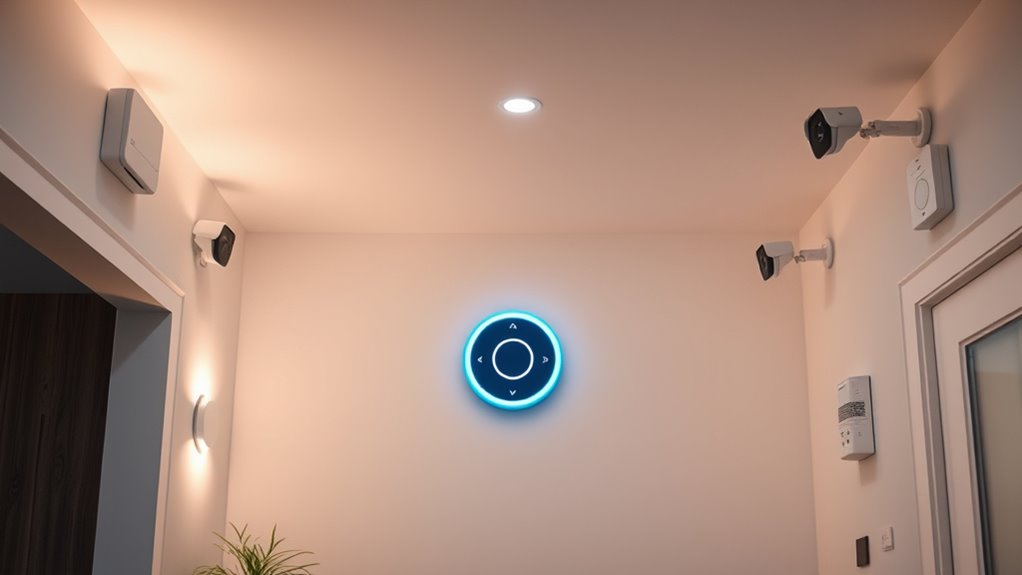
Have you considered how seamlessly integrating your security devices and sensors can elevate your home’s protection? By connecting motion detection sensors and facial recognition cameras to Home Assistant, you create a smarter security system. These devices provide real-time alerts and enhanced monitoring, making it easier to identify intruders or unwanted visitors. With proper integration, you can customize notifications, trigger alarms, or activate other automations instantly. To maximize effectiveness, focus on high-quality sensors and cameras that support facial recognition and accurate motion detection. This integration boosts security while reducing false alarms. Additionally, understanding security device integration can help you optimize your setup for better reliability and responsiveness.
Creating Automated Security Responses
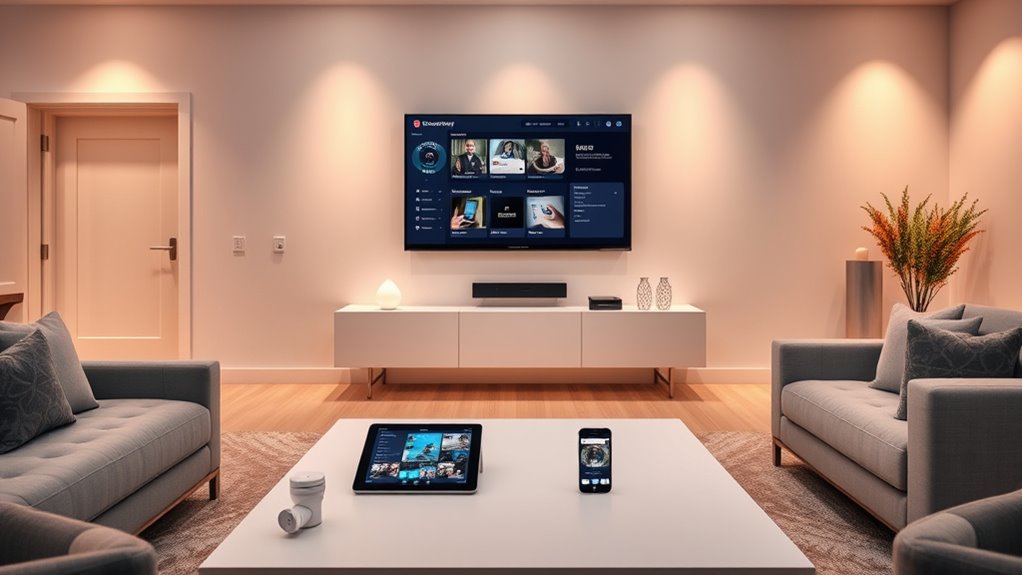
Building on your integrated security setup, creating automated responses guarantees your system reacts immediately to potential threats. When motion detection triggers, you can set your system to turn on lights, record footage, or send alerts. Facial recognition enhances this by identifying known individuals and flagging unfamiliar faces. For example, if motion is detected late at night and facial recognition identifies an intruder, Home Assistant can automatically activate sirens or lock doors. These responses help deter intruders and gather valuable evidence. Implementing animated movies can also create a calming environment when needed. You can customize triggers and actions to suit your security needs, ensuring a swift, effective reaction without manual intervention. Automating responses creates a proactive security environment, giving you peace of mind that your home is protected around the clock.
Monitoring and Alerting for Threats
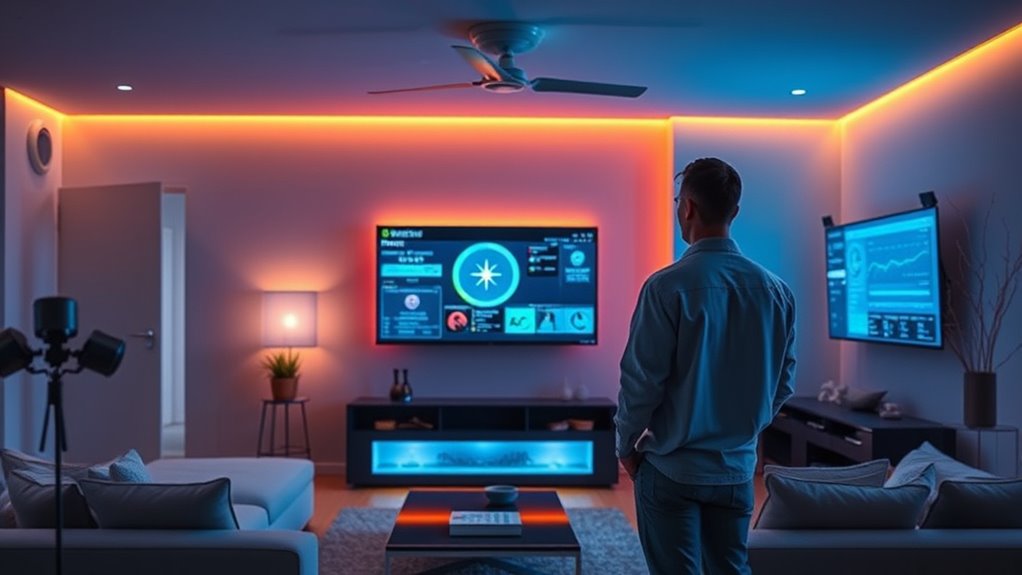
Effective threat monitoring and alerting are essential components of a security-focused automation hub. You need to track potential threats in real-time, ensuring quick responses to unauthorized access or suspicious activity. Implementing encryption protocols safeguards your data during transmission, preventing interception. Monitoring user access helps identify unusual login patterns or escalated privileges that could indicate compromise. To stay alert, set up system notifications for critical events like failed login attempts or device anomalies. Use Home Assistant’s integrations to automate alerts via SMS, email, or push notifications. Regularly review access logs and encrypted communications to detect vulnerabilities early. Staying vigilant with these tools helps protect your home network, ensuring threats are identified swiftly before they escalate. Cookies play a role in enhancing security by managing session data and user authentication, contributing to a safer environment.
Customizing Privacy and Data Control
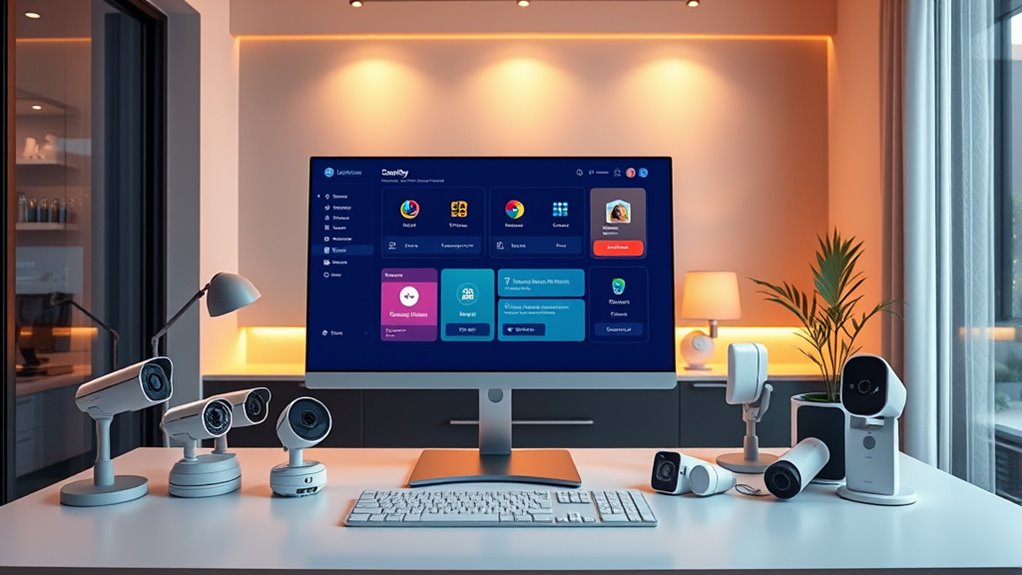
To guarantee your home automation remains private and secure, customizing privacy and data control settings is essential. You can strengthen security by selecting robust encryption protocols for data transmission, ensuring your information stays protected from eavesdropping or tampering. Managing user access is equally important; define who can view or modify your automation settings, and restrict permissions for guests or other devices. Regularly review access logs to monitor any suspicious activity. Additionally, disable unnecessary integrations and services that could expose sensitive data. You might also consider Vetted – Perfect Fit Living options for reliable and energy-efficient devices to further enhance your home’s security. By tailoring these settings, you maintain control over your personal information, reduce vulnerabilities, and foster a secure environment for your smart home. This proactive approach helps you stay ahead of potential privacy breaches while enjoying the convenience of automation.
Frequently Asked Questions
Can Home Assistant Detect and Respond to Cyber Threats?
You might wonder if Home Assistant can detect and respond to cyber threats. While it’s primarily designed for home automation, you can set up threat detection and response automation with integrations like network monitoring tools or security plugins. These enable you to identify unusual activity and trigger automated responses, improving your security. However, for extensive threat detection, dedicated cybersecurity solutions are recommended alongside Home Assistant.
How Secure Is Home Assistant’S Cloud Integration?
You wonder how secure Home Assistant’s cloud integration is, and it’s worth considering. It uses encryption practices to protect your data during transmission and storage, helping guard against unauthorized access. However, your security also depends on managing user access carefully, ensuring only trusted users can connect. While generally secure, always stay updated on security patches and review access controls to maintain your privacy and safety.
Is It Possible to Disable Remote Access Completely?
Yes, you can disable remote access completely in Home Assistant. To do this, guarantee all cloud integrations are turned off and disable remote access features. By keeping everything on your local network, you prevent external connections. Additionally, device isolation helps protect your system—by segmenting your Home Assistant from other devices, you reduce potential attack vectors. This setup maximizes security and keeps control entirely within your local network.
How Do I Back up My Security Configuration?
To back up your security configuration, you should implement effective backup strategies and regularly create configuration exports. Start by locating your Home Assistant’s supervisor or settings, then select “Snapshots” or “Backups.” These exports capture your current setup, including security settings and automations. Store backups securely offsite or in cloud storage. Regularly updating your backups ensures you can restore quickly if needed, maintaining your security integrity.
Can I Monitor Security Device Status Remotely?
You can monitor your security device status remotely by setting up real-time updates in your home automation system. Confirm your security devices support wireless protocols like Zigbee, Z-Wave, or Wi-Fi for seamless integration. Check device compatibility with your system to enable remote monitoring via apps or dashboards. This way, you get instant alerts and status updates, giving you peace of mind even when you’re away.
Conclusion
By turning your Home Assistant into a security-focused hub, you’re building a fortress that’s both smart and responsive. Think of it as a vigilant guard dog, always alert and ready to respond at a moment’s notice. With seamless device integration, automated responses, and customized privacy controls, you create a safe haven you can trust. Embrace these tools, and you’ll have peace of mind, knowing your home is protected like a castle guarded by an unwavering sentinel.
